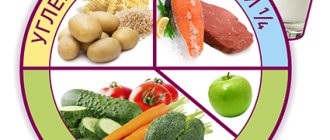It is no secret that young and not very experienced mothers receive information on feeding an infant, including recommendations on how to introduce the first complementary foods, mainly from two sources: grandmother’s stories and from the Internet. Unfortunately, both of these respected sources of information can, willingly or unwillingly, but be greatly mistaken, since grandmothers grew up in a more prosperous time in terms of environmental conditions, and the Internet is littered with various articles that are rarely written by professionals, moreover, they are based either on obvious outdated reference books on baby nutrition, or openly based on unverified information.
In this article, I will try to combine the latest scientific data and recommendations on the issue of how to introduce first complementary foods with many years of observations from the experience of a practicing pediatrician and allergist-immunologist.
At what age is it time to introduce the first complementary foods?
According to the recommendations of the Research Institute of Nutrition of the Russian Academy of Medical Sciences, the first complementary foods can be introduced from 4.5 to 5 months, regardless of the type of feeding. This is "on average". In practice, the choice of time to start introducing complementary foods still depends on the individual characteristics of the child. For example, we will not introduce complementary foods to a child with widespread atopic dermatitis (diathesis) until at least acute skin symptoms, such as cracks, weeping or secondary eczema, have disappeared. Increased dryness and flaking of the skin, of course, require constant application of moisturizers to the skin, but in no case are they a contraindication to the introduction of the first complementary foods.
Another important point when choosing the time to start introducing complementary foods is the dynamics of the child’s weight gain. The more rapidly a child gains height and weight, the sooner he may need additional calories, since the energy value of breast milk or formula alone will most likely not be enough for a child who is growing faster than his peers, most likely by 4–5 months. We must not forget that natural products contain a fairly wide range of minerals and vitamins, and the mother’s body, alas, cannot be an eternal and bottomless source of useful nutrients; somewhere somewhere something will gradually begin to be lacking.
In addition, the nature of the mother’s lactation has a great influence on the timing of the introduction of complementary foods. If a nursing mother begins to feel a lack of milk, I would prefer to first give her advice on stimulating lactation, and at the same time begin introducing complementary foods. This will be better than introducing an artificial mixture. But I repeat that the earliest date for starting the introduction of the first complementary foods is the age of 4 months; before that, the child’s body is not yet ready, and the risk of developing allergies is high.
So, we agree that the first complementary foods can be introduced no earlier than 4 months of a child’s life.
Introduction of complementary feeding to formula-fed premature infants
The question of the correct introduction of complementary foods to a premature baby should be discussed individually at an appointment with a pediatrician. In order for the body to process a new product, organs and systems must be sufficiently mature and prepared. The quality of food digestion largely depends on the production of special enzymes, so you should not show initiative in creating your baby’s menu.
The schedule for introducing complementary foods will be determined by the presence or absence of anemia, rate of weight gain, tendency to allergies and some other nuances. It is usually recommended that formula-fed premature babies begin introducing meat and egg yolk earlier. It is advisable to cook porridge in vegetable broth or mixture, rather than in water, as then they will be more nutritious and healthy.
IMPORTANT! However, the progress of complementary feeding must be monitored by a pediatrician. The doctor monitors the child’s reaction to new foods, assesses the dynamics of growth and general physical development. The scheme may be changed if any deviations from the norm are identified during routine inspections.
First feeding: Which foods to choose?
The first complementary foods, as a rule, should consist of vegetable or fruit purees, but in no case juices. Still, juices, even those for children, are highly filtered and mostly contain a large amount of organic acids and “light” carbohydrates (that is, sugar, so that everyone understands). I will not waste time explaining why juices are harmful to an infant, but will describe a clinical case from practice.
Parents with an 8-month-old girl came to the reception. From about 5 months on, I practically didn’t gain any weight, although before that all my indicators were normal. The tests, apart from visible signs of iron deficiency and slightly reduced hemoglobin, did not reveal any pathology. Main complaint: “he doesn’t eat anything.” And when I began to find out what she actually ate, it turned out that the child drinks half a liter of juice every day. But the two of them cannot force porridge or cottage cheese or mashed potatoes in; he spits it all out. I don't like the taste. And so - for three months. The child, naturally, became very nervous, screaming at night and demanding juice.
So, draw your own conclusions and be careful.
For the first feeding, this is now recognized by everyone, the best dishes are vegetable purees from green varieties of vegetables: zucchini, cauliflower, broccoli. The first complementary foods are introduced, starting with half a teaspoon, in the morning for three days, then gradually increase the amount of product to 40 - 50 grams per week. Supplement with breast milk or formula.
If you have problems with stool or constipation, it’s good to start introducing prune puree, green apple, you can try pumpkin, even apricot puree, but under no circumstances start with carrots. Beta-carotenoids, which are abundant in carrots, are generally poorly absorbed and can cause allergies in a child.
Complementary feeding table by month when breastfeeding
| Products | 6 months | 7 months | 8 months | 9 months | 10 months | 11 months | 12 months |
| Dairy-free porridge | 10–150 g | 150–180 g | 150–180 g | 180–200 g | 200 g | 200 g | 200 g |
| Vegetables | 10–120 g | 80–120 g | 150 g | 170 g | 180 g | 200 g | 200 g |
| Milk porridge | — | — | — | — | — | — | 160–200 ml |
| Fruits | 5–60 g | 50–60 g | 60 g | 80–100 g | 100–120 g | 100–120 g | 100–120 g |
| Meat | — | — | 10–30 g | 30–70 g | 60–70 g | 60–70 g | 80 g |
| Cottage cheese | — | — | 5–10 g | 10–30 g | 40 g | 40 g | 50 g |
| Yolk | — | — | ½ | ½ | ½ | ½ | ½–1 |
| Fish | — | — | — | — | 10–40 g | 10–40 g | 50–60 g |
| Vegetable oil | — | — | 1 ml | 3–5 ml | 5 ml | 5 ml | 5 ml |
| Butter | — | — | 1–3 g | 3–4 g | 5 g | 5 g | 5 g |
As you can see, the schemes for introducing complementary foods during breastfeeding and artificial feeding do not differ too much. In any case, when you start introducing new foods into your baby’s diet, you will have to give your baby milk or formula for a long time, which is still the basis of his nutrition.
Second feeding. Porridge or meat?
Even 5 - 6 years ago, we taught students at the medical institute that from 5 - 5.5 months, an infant should start giving grain porridge as complementary foods. This is rice, buckwheat, corn. For the first week, you can cook 5% porridge: 5 grams of ground cereal per 100 ml of water. Then the porridge is cooked more dense: 10 grams of cereal per 100 ml of water. But now, mostly everyone uses instant (soluble) cereals, which are diluted with water according to the instructions on the package. In addition, ready-to-eat liquid porridges are available for sale: for example, Bellakt, Frutonyanya, etc.
Why meat? You ask. According to modern recommendations (they really began to change quite often), but in this case I support: if a child by the age of 5 months has a pronounced decrease in hemoglobin in the blood below 100 g/l, it makes sense to start introducing fruit or vegetable purees as a second type of complementary feeding, meat purees as a source of the most easily absorbed heme iron. You need to choose from varieties such as turkey, rabbit, lamb. Beef and veal can only be offered to children who do not have red cheeks or diathesis.
If there are no problems with low hemoglobin, feel free to introduce porridge as the second course of complementary feeding, especially if the child is a “little one” and is not gaining weight very well. In this case, we can recommend diluting cereals with the addition of breast milk or formula (Nan, Nutrilon, Celia, Nanny). Parents of children with a predisposition to allergies should be very careful with goat milk-based formulas. Goat milk formulas are not the best choice for children suffering from allergies or intolerance to cow's milk protein, no matter what they write on the Internet. Believe me, there are serious scientific articles by foreign authors that provided data on a very high incidence of cross-allergy between cow's and goat's milk proteins in children who were transferred to goat's milk formulas. And I saw this myself in my practice, when a child with dermatitis was switched to goat’s milk formula, there was a clear improvement for a month or two, and then everything started again and with a doubled degree of allergic skin damage.
Introduction to complementary feeding of fermented milk products
This is the most difficult question. I am sure that most of our grandparents demand that their stupid parents start feeding their grandchildren milk and kefir as soon as possible. In some cases, children really begin to assimilate fermented milk products well after 6 months, but before this age I treat even fermented milk Agusha with great caution, and introducing milk or kefir before 6 months is bad form, believe me, and can lead to very negative consequences for the child. I understand the Western European medical community, which has recently completely banned its pediatricians from recommending fermented milk products as complementary foods for children under 3 years of age, imagine!
They (Europeans) need to put their artificial milk formula somewhere. Even 20 years ago, we did not know any other formulas after the “two”, that is, the second formula for children from 6 to 12 months. Then formulas appeared for children from 1 to 2 years old, then from 2 to 3 years old, and now there are formulas for children up to 4 years old, and I think if this goes on, then until the age of sixteen there will be milk substitutes. Excuse me, I don't think this approach is correct. But the fact is that our grandparents had much better genetics than the generation of our children, alas. With the growing capabilities of medicine, genetically determined diseases are also growing, and in this case, cow’s milk protein intolerance, and with every 10th anniversary there are more and more such people among us. But if a child really suffers from an allergy to cow’s milk protein or is severely deficient in enzymes, then he will carry this peculiarity throughout his life, and most likely he will not drink either milk or kefir, and there is no need to force him if he won't want to!
But you were lucky with your genetics, and no one in the family ever had allergies (which is hard to imagine nowadays), and most importantly, if your child has always had perfectly clear skin, then you will begin to offer the first dairy product - cottage cheese - to your child with 7 months, kefir - from 10 months. Milk - after a year. It will be better this way.
But if your family does not have a very close and joyful relationship with milk, then it is better to postpone even the introduction of kefir and yogurt into the child’s complementary foods until after 18 months.
What we focus on when introducing complementary foods:
The main criterion is the child’s readiness for the introduction of complementary foods - the child shows interest in food, the so-called food interest - he is interested in what his mother eats, actively reaches for food from his parents’ plate, wants to taste it.
Indirect criteria
- The child is about six months old
- The extinction of the “pushing” reflex for solid food (active interest in food never appears until the extinction of the pushing reflex)
- Doubling of birth weight (optional; some babies double their weight before 6 months of age)
- The child can sit with support
- The child's first teeth appear (again, not always)
Principles of maintaining interest in food
- Parents must remember that in order to form the main criterion for readiness for complementary feeding, the child must see how they eat in his family. The formation of eating habits comes from the family and the child’s immediate environment. If a baby has never seen mom or dad eat food, eat at the table, or what they eat before age 6 months, he or she may not develop an interest in food by age 6 months. Food interest begins to gradually develop as a skill of monitoring the actions of an adult from 3 months of age. That is, from about 3 months of age, if you take your child with you to the kitchen (dining room), the child begins to observe the process of eating, and gradually this interest - from the interest of “observation” moves to the “desire” to try just like mother or dad.
- It is advisable not to feed the child separately and try to eat with the child what the child eats. If you feed your child commercial food (ready-made purees in a jar), then try this food with your child. Even try to bring jarred food as close as possible to the general appearance on the table - transfer the puree from the jar to a plate, give it a spoon. At the age of 8-10 months, a child learns to eat with his hands, so at this age it is advisable for the child to have small pieces of food on his plate that he already eats - these can be pieces of boiled potatoes, broccoli, cauliflower, pieces of apple, banana. The pieces should be small, 1 x 1 cm, so that the child can grab them with his fingers. At the same time, the mother can supplement the baby’s main food from the plate. The child learns to cope with more solid food, learns to chew and swallow. The sooner the skill of swallowing solid food is mastered, the easier it will be for parents in the future. At the age of 10-12 months, the child’s fine motor skills are already improving, he learns to eat with a spoon (be patient, different children do this in different ways and at different speeds)
- Consider the physical condition of the child - do not introduce new foods when the child is unwell, or tired, or teething, or has undergone some kind of medical procedure - for example, a vaccination
- Offer small portions. Some children undereat their food because they are initially intimidated by the portion size. Do not insist that your child finish the portion. It’s better to ask for more after some time
- Try to keep your child's surroundings clean! This initially accustoms the child to cleanliness at the table and to eating neatly. Some children are very sensitive to external irritants - dirty hands, face, clothes can cause them severe discomfort
- Help your child if you see that the child is “interested” in food, but is tired of fighting it.
- No games, entertainment or persuasion while eating - this way you replace food interest with interest in the game. The child will not be able to learn to adequately evaluate his desires for food. There is no need to turn food into a performance.
Fish day and first feeding
Fish is a very healthy product, rich in vitamins and antioxidants, but it must also be administered carefully. I recommend starting to introduce the first fish complementary foods at approximately 7–8 months. It is better to start with species such as cod, hake, and haddock. The rules are the same: for the first three days, “grammatically”, then slowly increase. If there are no problems in a week or two, you can try delicacies such as tuna or salmon, canned children’s food, of course, if you can find it. It is better not to mess with trout and salmon in the first year of life, these fish are all stuffed with dyes and antibiotics.
No matter how hard I tried, the article about the first complementary foods turned out to be long. Thank you for reading to the end, I hope it will be useful. If you have questions about the introduction of complementary foods, you can write your requests on our website in the section asking a specialist. A short answer can be obtained on the Internet, but in order to make a diagnosis and give a detailed consultation, of course, you need to come to an in-person appointment with a pediatrician and children's allergist.
Why does a baby need complementary foods?
Breast-fed and bottle-fed babies are usually equally full of energy, active and inquisitive. Introducing complementary foods allows you to begin to gradually accustom the baby’s gastrointestinal tract to new food, as well as give the growing body the vitamins and microelements it needs at a specific stage of physical development. Also, with its help, you can gradually adapt the baby to the diet of adult family members and then painlessly transfer him to the common table. There are no exact norms and rules for introducing complementary foods. It is necessary to focus on the child’s needs and follow the pediatrician’s recommendations.











